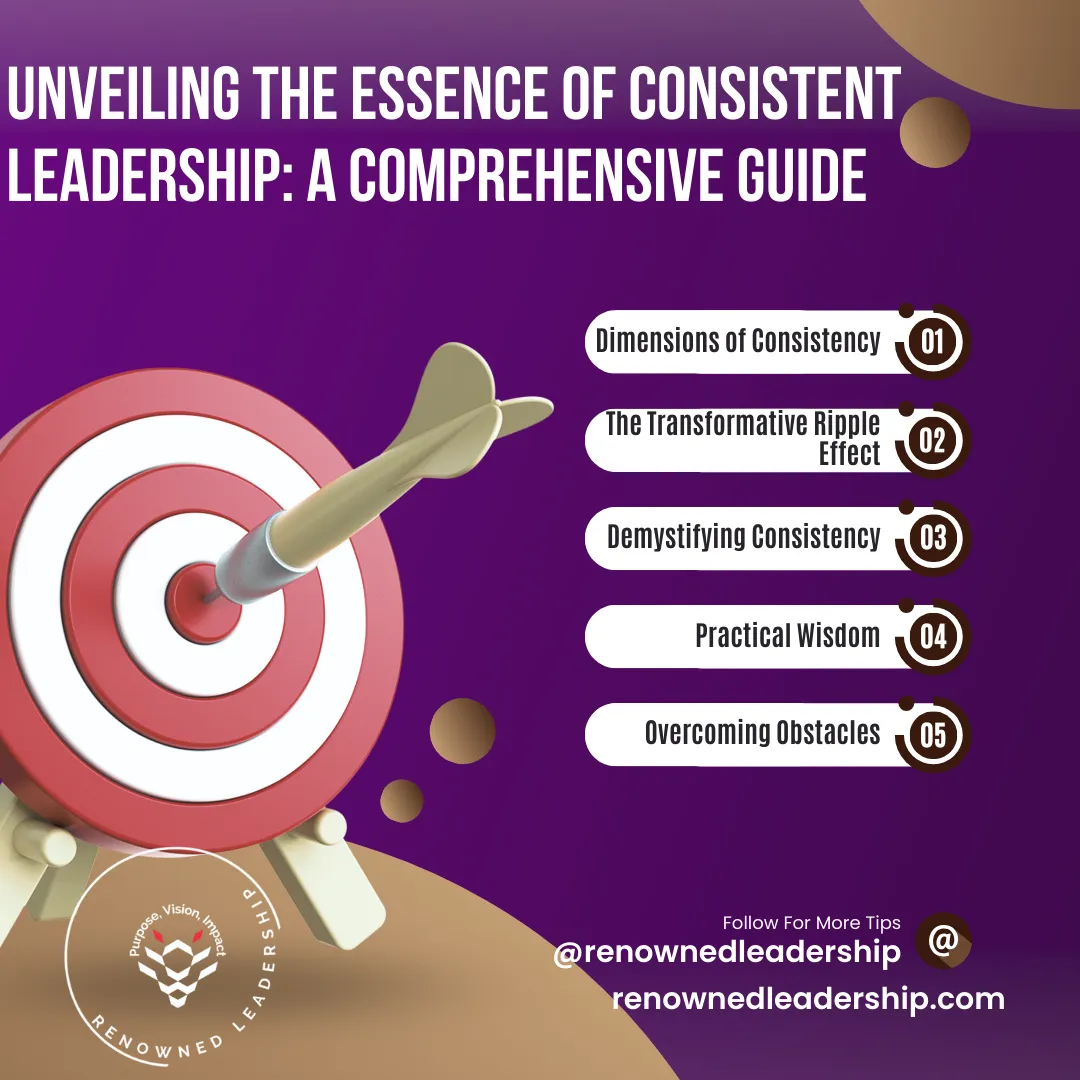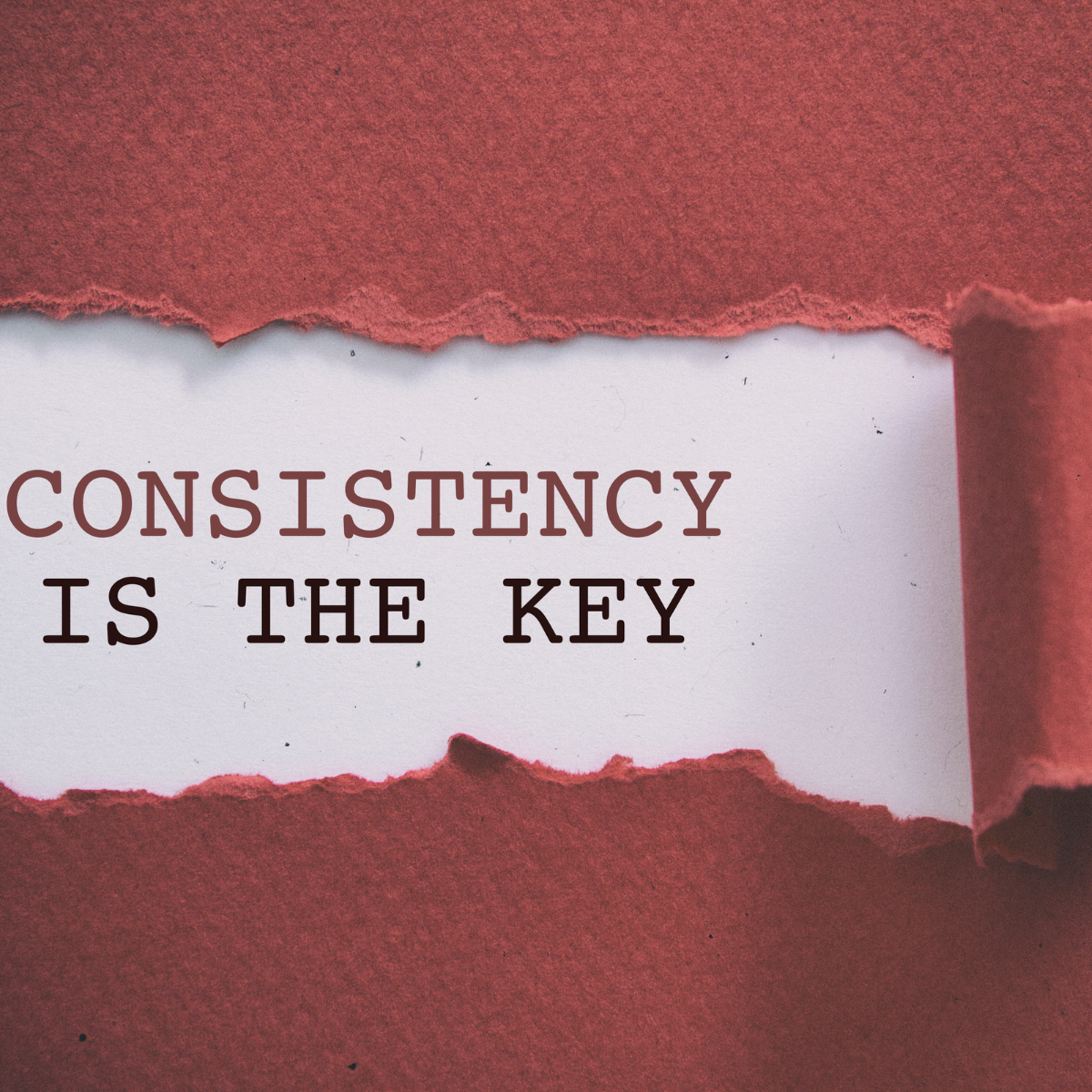The Renowned Blog

Unveiling the Essence of Consistent Leadership: A Comprehensive Guide
“At the heart of consistent leadership lies a clear set of core values, providing a stable foundation for decision-making aligned with organizational principles.” - Stephen J. Morris
Introduction:
In the intricate world of leadership, one pivotal element stands out as the linchpin of success: Consistency. As we navigate the complex fabric of leadership dynamics, it becomes evident that consistency is not a mere routine but a transformative force shaping the evolution of effective leadership.
Defining the Core of Consistent Leadership
Consistency in leadership goes beyond a superficial adherence to routines; it encapsulates the steadfast adherence to principles, values, and behaviors over time. It signifies reliability and predictability in a leader's actions, decisions, and communication. A consistent leader operates uniformly and is dependable, ensuring their behavior aligns with established standards and expectations.

“If you are consistently good, you consistently compound goodness.” - John C. Maxwell
Dimensions of Consistency
Behavioral Consistency
This dimension relates to a leader's actions and reactions in various situations. A consistent leader doesn't veer off course based on mood or external pressures.
Decision-Making Consistency
Consistent leaders apply a coherent decision-making process based on principles rather than impulsive choices across different scenarios.
Communication Consistency
Communication is a cornerstone of leadership; consistent leaders communicate clearly and predictably, aligning messages with established values.
Values Consistency
Core values remain unwavering and upheld in both words and actions, creating a foundation of trust and credibility.
Adaptability within Consistency
Consistent leaders maintain stability while embracing change, ensuring adaptability within the framework of guiding principles.
Foundations of Consistent Leadership
Consistency in leadership transcends routine; it represents a profound set of core principles that serve as the guiding light for leaders. These principles, including integrity, transparency, and a relentless pursuit of excellence, create a framework that sets expectations and becomes the moral compass steering leaders through challenges and uncertainties.
The Transformative Ripple Effect
As consistency ripples through leadership, its impact extends beyond the boardroom, permeating personal connections within a team. Real-world examples vividly illustrate the transformative effect of consistent leadership, fostering an environment conducive to collaboration, innovation, and shared success.
Navigating the Complex Landscape
Delving into the multifaceted landscape of leadership requires a compass, and the 5 Ws—Who, What, When, Where, Why, and How—serve as our navigational guide. These questions connect theoretical concepts to real-world scenarios, illuminating the path for leaders seeking a consistent and practical approach to leadership dynamics.
Who Benefits from Consistent Leadership?
The 'Who' extends beyond the leader alone, encompassing every individual within the organizational ecosystem. Recognizing this wide-reaching impact underscores the inclusive nature of effective leadership.
What Are the Key Elements of Consistent Leadership?
The 'What' invites leaders to dissect the core elements that define consistent leadership, embodying fundamental principles such as integrity and unwavering commitment to organizational values.
When Should Leaders Prioritize Consistency?
The 'When' emphasizes that consistency isn't sporadic but a constant focus, acknowledging that its impact unfolds in critical moments and in the consistent rhythm of daily leadership.
Where Does Consistent Leadership Play a Crucial Role?
The 'Where' transcends physical locations, extending from the boardroom to the frontline, recognizing diverse landscapes where consistent leadership is essential.
Why Is Consistent Leadership Essential?
The 'Why' serves as the North Star, guiding leaders to the fundamental rationale behind the pursuit of consistency, reinforcing that it's a fundamental ethos defining effective leadership.
How Can Leaders Incorporate Consistency into Their Daily Practices?
The 'How' provides a practical roadmap, detailing actionable steps to weave consistency into daily practices, offering tangible strategies to cultivate and sustain consistency.
Demystifying Consistency: Addressing Common Misconceptions
In the labyrinth of leadership theories, consistency often carries misconceptions, hindering a nuanced understanding of its true nature. Let's address these myths to unveil the authentic essence of consistent leadership.
Myth 1: Consistency Implies Inflexibility
Consistency does not mean unwavering adherence to a fixed path; instead, it involves a steadfast commitment to principles while remaining adaptable to the organization's evolving needs.
Myth 2: Consistency Stifles Creativity and Innovation
Consistency catalyzes innovation when applied judiciously, fostering an environment where team members feel secure and supported in thinking creatively.
Myth 3: Consistency Equates to Predictability
Consistency means a reliable and principled approach rather than a dull and formulaic routine, allowing for strategic surprises and creative initiatives.
Practical Wisdom: Strategies for Developing Consistency in Leadership
Transitioning from the conceptual realm to the practical domain requires a deep understanding of strategies underpinning the development and sustenance of consistency in leadership.
Strategy 1: Define Core Values with Clarity
At the heart of consistent leadership lies a clear set of core values, providing a stable foundation for decision-making aligned with organizational principles.
Strategy 2: Communicate Consistently and Transparently
Consistency in communication is paramount, as well as building trust and fostering a shared understanding of the corporate direction.
Strategy 3: Prioritize Decision-Making Frameworks
Establish decision-making frameworks aligned with organizational values, ensuring decisions are consistent and contribute to organizational stability.
Strategy 4: Lead by Example
Leaders must embody the consistency they seek, consistently demonstrating the values, behaviors, and work ethic expected from the team.
Strategy 5: Establish Rituals and Routines
Creating rituals and routines instills a sense of predictability, providing a structured framework within which the team operates.
Strategy 6: Seek Feedback and Iterate
Consistent leadership is an evolving process; leaders should actively seek feedback to refine and adapt their approach.
Strategy 7: Foster a Culture of Accountability
Consistency thrives in a culture of accountability, where clear expectations and responsibility contribute to a principled culture.
Overcoming Obstacles: Challenges and Solutions in Leadership Consistency
Recognizing challenges in maintaining consistent leadership is paramount to fostering enduring success. Let's delve into pragmatic solutions empowering leaders to navigate complexities.
Obstacle 1: Adapting to Change without Compromising Consistency
Embrace an adaptable form of consistency, aligning guiding principles with new realities to ensure stability amid change.
Obstacle 2: Balancing Consistency with Innovation
Create a culture that encourages innovative ideas within the framework of established values, striking a harmonious balance.
Obstacle 3: Navigating Leadership Transitions
Ensure a seamless handover, explicitly communicating enduring principles and values to preserve organizational consistency.
Obstacle 4: Overcoming Communication Breakdowns
Prioritize transparent communication channels, seeking feedback to address concerns and consistently communicate organizational vision and values.
Obstacle 5: Balancing Personalization with Consistency
Recognize that consistency does not mean a one-size-fits-all approach, allowing leaders to personalize interactions within the broader context of organizational consistency.
Triumphs Through Overcoming Obstacles
Triumphs in consistent leadership emerge not in the absence of challenges but in the adept navigation and resolution of obstacles. Addressing these challenges cultivates a culture of resilience, adaptability, and sustained success.
Conclusion: Navigating the Journey of Consistent Leadership
In the intricate tapestry of leadership, the linchpin of success reveals itself as the transformative force of consistency. As we navigate the complexities of leadership dynamics, it becomes clear that consistency transcends routine; it is a guiding philosophy shaping the evolution of effective leadership. The essence of consistent leadership goes beyond mere adherence to routines, encapsulating the unwavering commitment to principles, values, and behaviors over time. This reliability and predictability in a leader's actions, decisions, and communication form the bedrock of a consistent leader's approach, ensuring alignment with established standards and expectations.
As we dissect the dimensions of consistency, from behavioral and decision-making to communication and values, the foundations of consistent leadership emerge as a profound set of core principles. These principles, including integrity, transparency, and a relentless pursuit of excellence, create a moral compass steering leaders through challenges and uncertainties. The transformative ripple effect of consistency extends beyond the boardroom, fostering an environment conducive to collaboration, innovation, and shared success. Navigating this complex landscape requires a compass and the 5 Ws—Who, What, When, Where, Why, and How—serve as our guide, connecting theoretical concepts to real-world scenarios. Recognizing the inclusive nature of effective leadership, leaders must prioritize consistency in daily practices and weave it into the fabric of their organizations. In dispelling common misconceptions, embracing practical wisdom, and overcoming obstacles, leaders can triumph in the perpetual journey of consistent and impactful leadership, both offline and in the digital realm.
BE CONSISTENT | MWM
Q: What distinguishes consistent leadership from routine adherence?
A: Consistent leadership transcends routine by embodying unwavering commitment to principles, values, and behaviors over time. Unlike mere adherence to routines, it forms a transformative force shaping effective leadership evolution.
Q: How does consistent leadership create a ripple effect beyond the boardroom, fostering collaboration, innovation, and shared success?
A: The transformative ripple effect of consistent leadership extends to personal connections within a team. Real-world examples vividly illustrate its impact, creating an environment conducive to collaboration, innovation, and collective success.
Q: What practical strategies and wisdom guide leaders in incorporating consistency into daily practices and overcoming common misconceptions?
A: Strategies such as defining core values, transparent communication, and fostering a culture of accountability are key. Practical wisdom dispels myths, allowing leaders to triumph over obstacles and navigate the perpetual journey of impactful and consistent leadership.

Stephen J. Morris
December 10, 2023
Founder & CEO
Renowned Leadership
©️ 2023
Never miss a new post!
Subscribe to our blog for free so you never miss the latest from Renowned Leadership.
We respect your privacy. Your information is safe with us and will never be shared. By submitting your email, you agree to receive occasional updates and valuable resources from us. You can unsubscribe at any time.

© 2024 Renowned Leadership LLC

